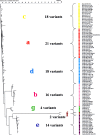Multicenter evaluation of a sequence-based protocol for subtyping Shiga toxins and standardizing Stx nomenclature
- PMID: 22760050
- PMCID: PMC3421821
- DOI: 10.1128/JCM.00860-12
Multicenter evaluation of a sequence-based protocol for subtyping Shiga toxins and standardizing Stx nomenclature
Abstract
When Shiga toxin-producing Escherichia coli (STEC) strains emerged as agents of human disease, two types of toxin were identified: Shiga toxin type 1 (Stx1) (almost identical to Shiga toxin produced by Shigella dysenteriae type 1) and the immunologically distinct type 2 (Stx2). Subsequently, numerous STEC strains have been characterized that express toxins with variations in amino acid sequence, some of which confer unique biological properties. These variants were grouped within the Stx1 or Stx2 type and often assigned names to indicate that they were not identical in sequence or phenotype to the main Stx1 or Stx2 type. A lack of specificity or consistency in toxin nomenclature has led to much confusion in the characterization of STEC strains. Because serious outcomes of infection have been attributed to certain Stx subtypes and less so with others, we sought to better define the toxin subtypes within the main Stx1 and Stx2 types. We compared the levels of relatedness of 285 valid sequence variants of Stx1 and Stx2 and identified common sequences characteristic of each of three Stx/Stx1 and seven Stx2 subtypes. A novel, simple PCR subtyping method was developed, independently tested on a battery of 48 prototypic STEC strains, and improved at six clinical and research centers to test the reproducibility, sensitivity, and specificity of the PCR. Using a consistent schema for nomenclature of the Stx toxins and stx genes by phylogenetic sequence-based relatedness of the holotoxin proteins, we developed a typing approach that should obviate the need to bioassay each newly described toxin and that predicts important biological characteristics.
Figures



References
-
- Asakura H, et al. 1998. Detection and long-term existence of Shiga toxin (Stx)-producing Escherichia coli in sheep. Microbiol. Immunol. 42:683–688 - PubMed
-
- Bastian SN, Carle I, Grimont F. 1998. Comparison of 14 PCR systems for the detection and subtyping of stx genes in Shiga-toxin-producing Escherichia coli. Res. Microbiol. 149:457–472 - PubMed
Publication types
MeSH terms
Substances
Grants and funding
LinkOut - more resources
Full Text Sources
Other Literature Sources

